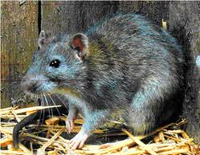RATS AND MICE


Rodents are troublemakers that can damage your property and cause a number of sometimes serious health problems. Rats and mice carry fleas and lice, and can transmit a variety of diseases. They multiply rapidly and, if an infestation goes unchecked, become an out-of-control problem in a very short time.
The best way to prevent a rodent infestation and contact with rodents is to remove the food sources, water, and items that provide them with shelter. Mice can squeeze through a hole the size of a nickel, and rats can squeeze through a hole the size of a half dollar! Prevent rodents from entering your home by checking inside and outside the house, and quickly seal up any gaps or holes you find.
Worldwide, rats and mice spread over 35 diseases. Rodent-borne diseases are spread directly to humans through a number of avenues, including:
* Bite wounds
* Consuming food or water that is contaminated with rodent feces
* Coming in contact with surface water contaminated with rodent urine
* Through breathing in germs that may be present in rodent urine or droppings that have been stirred into the air (a process known as "aerosolization").
Diseases from rodents are also spread indirectly to humans by way of ticks, mites, and fleas that transmit the infection to humans after feeding on infected rodents. In some cases, the rodents are the reservoirs (carriers) of the diseases, while in other cases the ticks, mites, or fleas act as the disease reservoirs.
Roof Rats

The roof rat is also known as the black rat, the rodent was called the black rat mostly in the Middle Ages. The rat’s name is also a reminder of the plague or Black Death, which the species was the initial carrier of the plague. Still to this day the roof rat still carries just as harmful diseases on its body. Also the roof rat can carry fleas, lice, bacteria, and parasites. The health implications are serious, and unlike spiders or scorpions they do not have to physically bite a person to infect them. Roof rat’s droppings that are often left behind, sometimes in gross high amounts, can cause a person to become ill. Not only are the rats carriers of diseases, what they leave behind can still have the potential to get a person sick. See how to handle this situation if it occurs by reading our blog on the diseases roof rats carry.
If you see droppings, how are you to know they are from a roof rat or a common house mouse? The droppings of a roof rat are actually long and cylindrical; the droppings are the most useful tool to determine if they have infiltrated your home. These rodents are nocturnal, so catching them out and about in your home in the day does not usually happen. It is what the rat leaves behind that will help you decide how to handle them. Although there is a chance you could find them sleeping in your attic. In order to tell if the rat is an actual roof rat look for these characteristics they can be as long as 18 inches, sometimes their tails are shorter than their bodies, have large ears and have a brown to black colored fur.
Although roof rats can range anywhere from 13 to 18 inches long it only takes a small hole for them to enter a home through. A local pest control company can come to a home and close up any entries from the outside into the home.
Norway Rats

Also called the brown rat, house rat, barn rat sewer rat, gray rat or wharf rat, it is a slightly larger animal than the roof rat. Adult Norway rats weigh an average of 1 pound. Their fur is coarse and usually brownish or reddish-gray above and whitish gray on the belly. Blackish individuals occur in some locations. Although they can climb, Norway rats tend to inhabit the lower floors of multistory buildings.
The Norway rat (Rattus norvegicus) lives in close association with people. In urban or suburban areas they live in and around residences, in cellars, warehouses, stores, slaughterhouses, docks and in sewers. On farms they may inhabit barns, granaries, livestock buildings, silos, and kennels. They may burrow to make nests under buildings and other structures, beneath concrete slabs, along stream banks, around ponds, in garbage dumps and at other locations where suitable food, water and shelter are present.
Norway rats consume and contaminate foodstuffs and animal feed. They may damage crops in fields prior to and during harvest, and during processing and storage. Rats also damage containers and packaging materials in which foods and feed are stored.
Rats cause structural damage to buildings by burrowing and gnawing. They undermine building foundations and slabs, cause settling in roads and railroad track beds, and damage the banks of irrigation canals and levees. Rats also may gnaw on electrical wires or water pipes, either in structures or below ground. They damage structures further by gnawing openings through doors, window sills, walls, ceilings, and floors. Considerable damage to insulated structures can occur as a result of rat burrowing and nesting in walls and attics.
EXCLUSION
Trapping and exclusion is the only way to permanently solve infestations and that our specialized exclusion services are fully guaranteed as long as the property qualifies.

